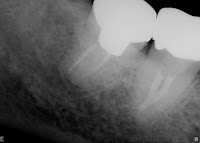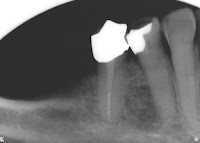 |
| Pre Op # 14 |
Fractured mesial buccal root. Patient had option to extract with implant or mesial buccal root amputation.
 |
| Final Film #14 |
Mesial buccal root removed. Solid bone around distal buccal and palatal roots.
 |
| Post Op 7 Months #14 |
Healing has occurred with bone fill in in the area of the mesial buccal root. Probing is within normal limits.
 |
| Post Op 13 Months #14 |
13 Months with crown. Pt extremely happy. No periodontal problems.
Comment: Some patients just do not want teeth removed. If within reason there are alternative treatments for fractured teeth, for instance, if a fractured root can be removed with no undue periodontal problems and the patient understands the home care situation, then amputation is a viable option. The patient must understand that a new crown has to be placed.













































